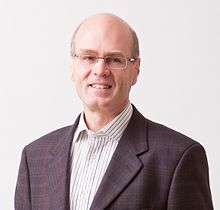Björn Ottersten
| Björn Ottersten | |
|---|---|
 | |
| Born |
1961 Stockholm, Sweden |
| Fields | Array Signal Processing, Wireless Communication |
| Institutions | University of Luxembourg, KTH Royal Institute of Technology |
| Alma mater |
Stanford University Linköping University |
| Doctoral advisor | Thomas Kailath |
| Known for | Space-division multiple access,MIMO |
| Notable awards |
2014 Cedergren Medal, H.T. Cedergren Foundation for outstanding contributions to electrical engineering; |
|
Website wwwen | |
Björn Ottersten (born 1961) is a Swedish educator, researcher,[1][2] and electrical engineer who is the co-inventor of Space/Spatial Division Multiple Access (SDMA) technology.[3] He has made contributions in array signal processing and wireless communications and has received many notable awards in these areas. Currently, he is a Professor of Signal Processing at Royal Institute of Technology (KTH),[4] Stockholm, Sweden, and the founding director of the Interdisciplinary Centre[5] for Security, Reliability and Trust, at University of Luxembourg, Luxembourg. He is a Fellow of the IEEE and EURASIP.[6]
From 2012, he has been an advisor to the European Commission, serving as the European Digital Champion of Luxembourg.[7] He also serves as a Board Member of the Swedish Research Council, as well as the Editor-in-Chief of the EURASIP Signal Processing journal.[8]
Biography
He received the M.S. degree in electrical engineering and applied physics from Linköping University, Linköping, Sweden, in 1986. In 1989 he received the Ph.D. degree in electrical engineering from Stanford University, Stanford, CA. His advisor at Stanford was Thomas Kailath.[9]
References
- ↑ "Ottersten, Björn". worldcat.org. Retrieved October 22, 2016.
- ↑ "Bjorn Ottersten". scholar.google.com. Retrieved October 22, 2016.
- ↑ "Website".
- ↑ "Trapped by an avalanche, saved by an app". phys.org. March 14, 2014. Retrieved October 23, 2016.
- ↑ "Jean-Louis Schiltz : Après le secteur financier, la prochaine étape consiste à s'intéresser aux monnaies virtuelles En savoir plus sur http://www.lesechos.fr/30/01/2014/LesEchos/21616-145-ECH_jean-louis-schiltz-----apres-le-secteur-financier--la-prochaine-etape-consiste-a-s-interesser-aux-monnaies-virtuelles--.htm#TMdAxV2ES7FF8SEy.99". lesechos.fr. January 30, 2014. Retrieved October 23, 2016. External link in
|title=(help) - ↑ "EURASIP".
- ↑ "The Digital Champion of Luxembourg".
- ↑ "Signal Processing Journal".
- ↑ "Thomas Kailath". web.stanford.edu. Retrieved 2016-10-26.